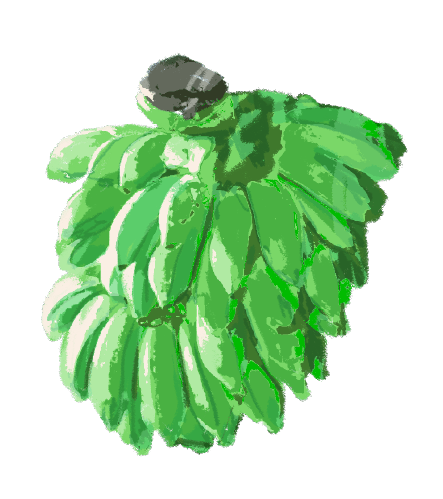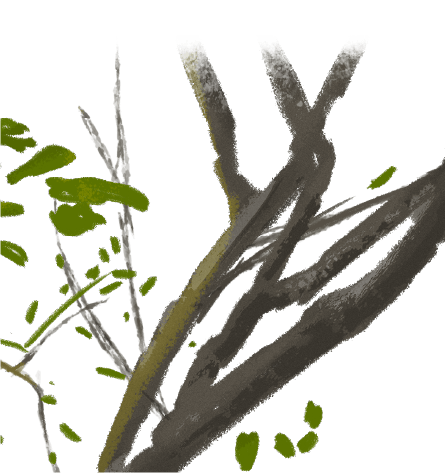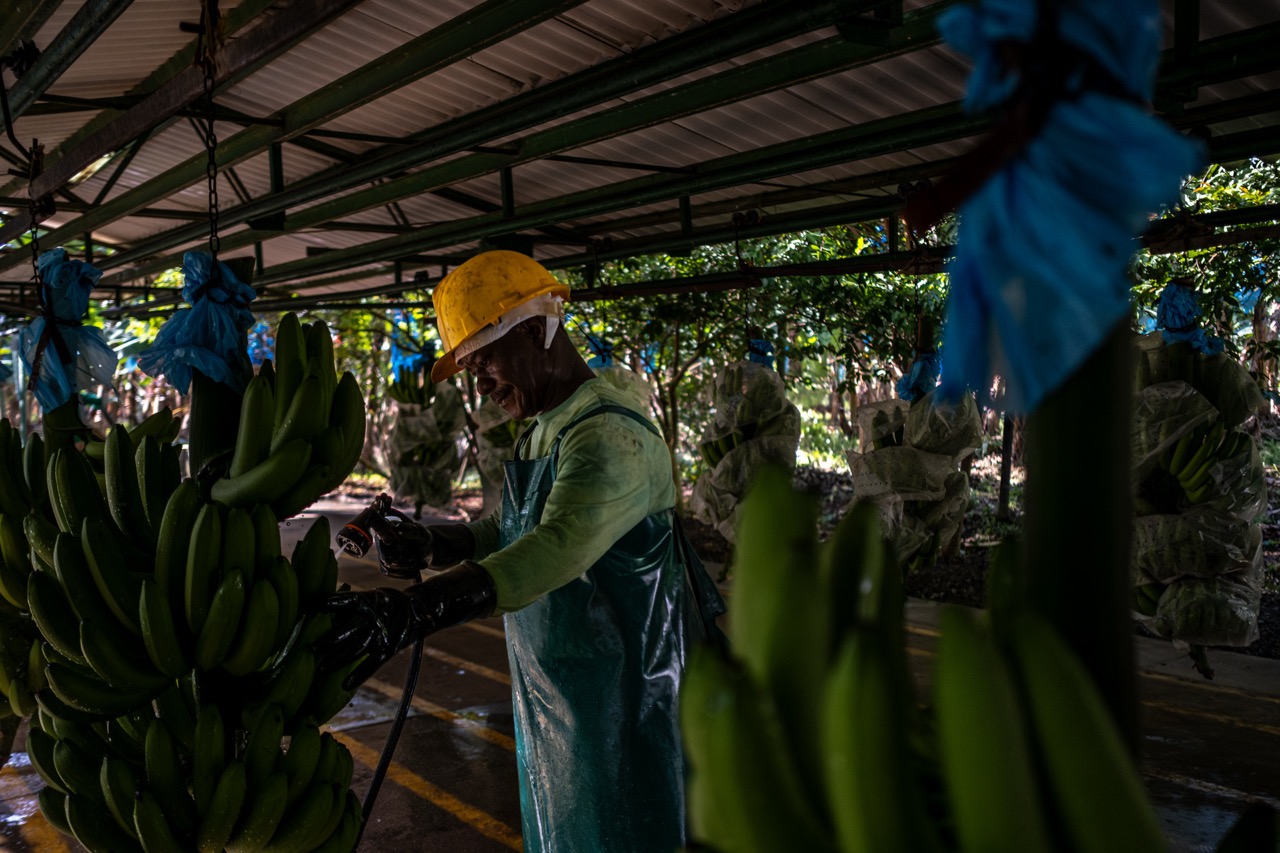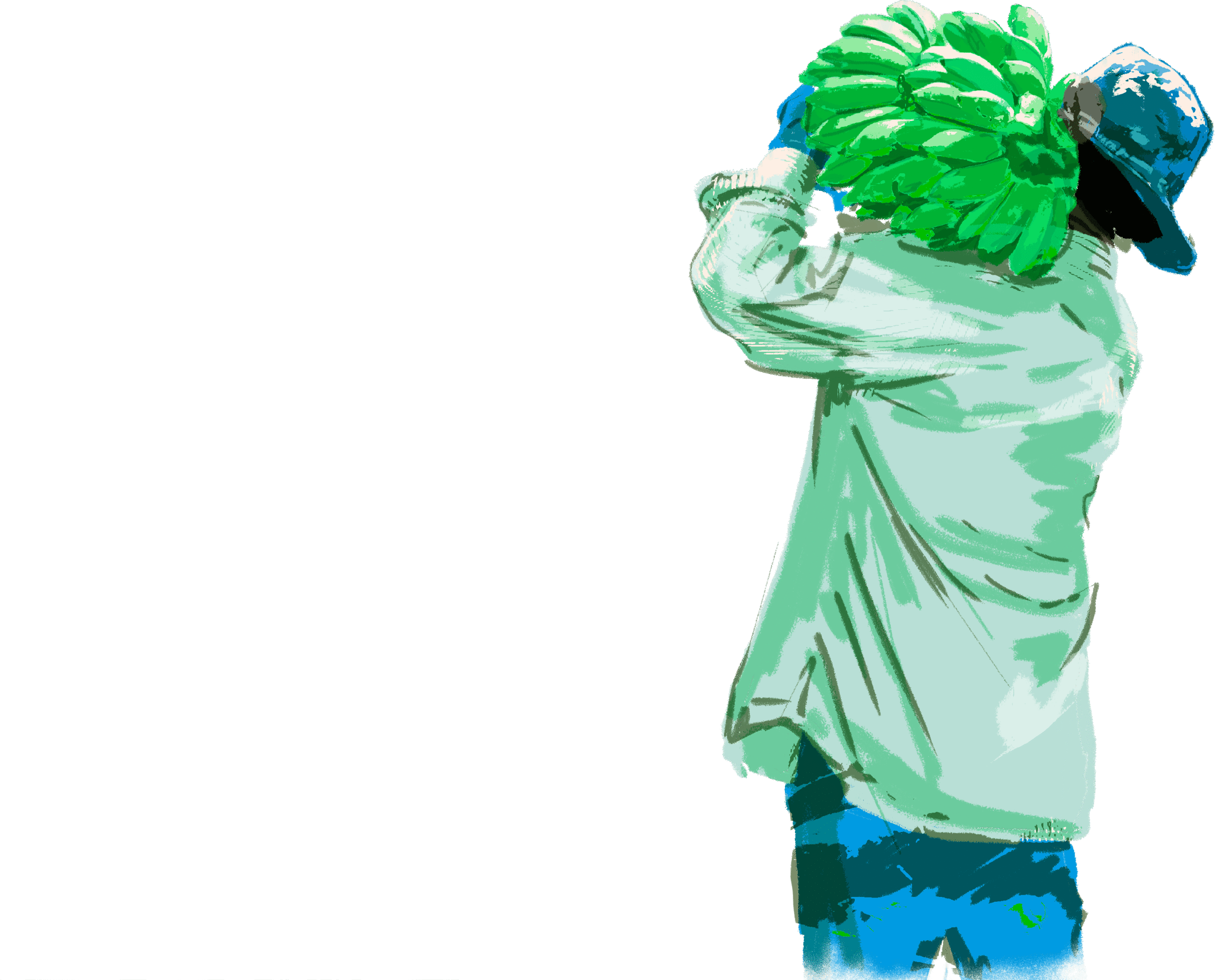Hard Days
in a Union
Man’s Life
1
Guillermo Rivera,
President of
Sintrainagro
They call him a survivor. A union leader who lived through several attempts on his life during the bleakest years of violence in Urabá. His name is José Guillermo Rivera Zapata. He is seventy, and he is known simply as Guillermo Rivera. “Here and across Colombia there has been a policy against the union struggle,” he says. “And we had to face it.”
Rivera is cautious about revisiting the episodes in which his life was at risk. There is no exhaustive public record of every attack. It is known that in February 2015, on a Tuesday night after a day’s work in the town of Florida, Valle del Cauca, two gunmen opened fire on the SUV taking him back to Cali. The armor of the vehicle and the skill of the driver saved his life.
It is also known that the first attempt came in the late nineteen-eighties, when he was a husband and a father, a man in his thirties living in the Pueblo Nuevo neighborhood of Apartadó. A group of men emptied their magazines into the house where he lived with his family. “They tore my house apart with bullets,” he recalls. “I had a boy, a girl, and my wife. After that attack, they moved to Medellín and I stayed.”
People close to Rivera call him a legend. They say he was able to bring stability to the banana sector. Some plantation owners and investors admit to feeling uneasy at the idea that he might die unexpectedly. They fear a rupture in the social and political balance that has allowed the industry to grow for three decades. “We are concerned about what could happen,” says an executive at a banana trading company.
“Here and across Colombia there has been a policy against the union struggle”

2
Rivera’s relationship with banana work began in the late nineteen-sixties, when he was fourteen and just entering adolescence. On a farm called Victoria del Río, now part of urban Apartadó, he did every job a plantation required. He prepared the ground, planted, cut, hauled, and packed. “I never studied. The farm was my school.”
In those years, and through the seventies, the work meant long hours and deprivation. Days stretched to eighteen or twenty hours. There was no extra pay for Sundays or overtime. Rest was rare. Colombia’s labor code was a distant rumor. Few workers knew that after two months they were entitled to severance for unfair dismissal. Many did not know they had the right to unionize. A good number of investors and owners did not concern themselves with how the law defined the relationship with their workers. They believed the labor code ran against their interests.
Single men and families lived on the plantations in camps that quickly became slums. There was no potable water, no electricity, no sanitation, and no social security. A foreman claimed the authority to beat or insult them if he saw fit. “There was electricity for the bananas, not for the workers,” Rivera says. “We drank water from the canals. If you got sick, you lost your job.”
In 1986, he put away his boots and machete and was elected to lead Sintagro, a union that seemed to bring together most of Urabá’s banana workers. Two other unions represented the rest of the labor force, Sintrabanano and Sindejornalero. By then, workers had won the right to be heard. Conditions were in constant dispute. Mobilizations and strikes pressed the case. A political opening under President Belisario Betancur gave space to Marxist currents and to the guerrillas. “It was a complicated time,” Rivera says. “The unions had arisen in a politics of confrontation. There was no trust between employers and workers. There was violence. We had no experience with union work in the banana sector.”
The three unions had civilian origins in the sixties and seventies, but by 1982 their leaders were already influenced by the guerrillas. The base was working-class and civilian. The positions were militant. Many decisions carried an anti-capitalist stamp. Sintagro drew cadres from the Popular Liberation Army, trained in the Marxist-Leninist Communist Party. Sintrabanano was guided by members of the Colombian Communist Party and aligned with the FARC. Sindejornalero included cadres linked to the ELN.
Tensions overlapped. The guerrillas, in the name of land redistribution, extorted and kidnapped owners and attacked infrastructure. The state’s dark units carried out a dirty war. There were selective murders, disappearances, persecution, and judicial frame-ups against union leaders. Between these poles, the workers acted. They filed demands, struck to insist on reforms, halted shipments, and slowed routines to seek wage adjustments and back pay. Employers compiled blacklists, passed names to the security forces, and carried out mass layoffs.
In 1987, a pivotal year for the industry, the three unions presented a joint proposal that covered more than two hundred collective agreements. It was a way to insist that any deal be representative of the sector. That unity mirrored efforts by the guerrillas to coordinate under the Simón Bolívar Guerrilla Coordinating Board. The Association of Colombian Banana Growers, Augura, accepted the proposal. It tied wage ceilings to productivity at each plantation. Private enterprise in Colombia had not tried this before. It was a significant achievement for the workers. “Before, bargaining was farm by farm,” Rivera says. “It was chaotic. Some farms had finished, others were negotiating, others were on strike. There were about four hundred farms. I wrote to José Manuel Arias Carrizosa, the president of Augura, to introduce myself as a banana worker. I listed the farms where I had worked. I told him I was still a worker, only now in the union, and I wanted a different relationship. We needed a model of bargaining that they could control and we could control. We began with ten groups. There were about forty farms in each group. It was easier than going farm by farm.”
The Ministry of Labor and the newly formed CUT took part. Rivera and his team won improvements that modernized the industry and that still hold. Augura recognized the unions as legal counterparts. The leaders promised to distance themselves from guerrilla violence. Augura granted job stability, an eight-hour day over six days, union protections, wage increases, and the start of dismantling on-site camps, with financing for urban housing. “We got workers out of the farms and into the municipal centers,” Rivera says. “That is when the land occupations began in Apartadó and Turbo and other towns. Three or four hundred workers would take a lot and build homes. Many people were massacred in that process, but they did not leave. Later, the government legalized those neighborhoods and workers paid for their homes. Today they live in decent houses and have access to credit.” The unions shifted their demands toward the state. The focus moved to education, health care, and recreation.
SHARED VALUE
3
The violence did not stop. From February to September 1987 there were forty murdered union members. The headquarters of Sintagro was destroyed by a bomb. Paramilitaries under Fidel Castaño appeared. In early 1988 the most brutal massacres began. Peasants and plantation workers were killed in camps, hamlets, and town neighborhoods. Honduras and La Negra left twenty dead. Punta Coquitos left twenty-six.
That May brought Colombia’s first popular elections for mayors and governors. The Patriotic Union, a left coalition that included communists, won two mayoralties. Apartadó was the most important, the principal banana municipality, and Mutatá followed.
The national government and the industry saw the result as a loss. They believed space had been ceded to the guerrillas. The unions saw a victory. Inside the rank and file a split widened. A majority still believed in confrontation and in the combination of forms of struggle. A smaller group was exhausted by the bloodshed. It argued that rights could only be won by negotiation and by building trust with employers.
Strikes and mobilizations continued. Some were still tied to the previous year’s bargaining. Most demanded state action on killings, disappearances, and massacres. The government of Virgilio Barco created a Military Command that granted an army general broad authority over public order. In August 1988 the command set new closing hours for public establishments. Soon it ordered mandatory ID cards for all banana workers. The stated purpose was to keep outsiders off the plantations.
The unions rejected the plan. They argued that the real goal was to collect information on workers and their families. The rank and file organized the largest strike to that point. Twenty-six thousand workers raised their hands and demanded the demilitarization of rural zones, criminal investigations into the massacres, the dismantling of paramilitary groups, the repeal of the ID plan, and the removal of General Arias Cabrales. The strike paralyzed transport and commerce. The guerrillas sabotaged electrical systems and packing plants. The Barco administration sent a commission that agreed to suspend the ID plan. By late September 1988, work resumed.
Weeks later, the Interior and Labor ministries stripped the three banana unions of their legal status. “We took part in the strike, and at the employers’ request the government suspended our legal recognition,” Rivera says. For the security forces and for many employers there was no distinction between unions and guerrillas.
At least three hundred collective agreements fell into limbo. With production stalled, employers accepted a solution proposed by the leaders of Sintagro, Sintrabanano, and Sindejornalero. All members would be consolidated into Sintrainagro, a union founded in 1974 for palm-oil workers. The new board gave six of ten seats to Sintagro, three to Sintrabanano, and one to Sindejornalero. Jesús Alirio Guevara became president. Rivera, also from Sintagro, became vice president.
The board’s tilt was read by the EPL as a political victory. Urabá was its stronghold. Control of a union representing some twenty thousand workers translated into power without rifles. A new National Constituent Assembly was on the horizon. The EPL entered peace talks in June 1990. The result was disarmament and reintegration for about eighteen hundred fighters. On March 1, 1991, a political movement launched with the same initials and a different meaning. Esperanza, Paz y Libertad. Hope, Peace, and Liberty.
The demobilization brought a brief optimism. A report in El Tiempo on March 1, 1991 noted that political killings had dropped by almost eighty percent since talks began. As vice president of Sintrainagro, Rivera told the press that massacres were no longer weekly. He credited negotiations with the EPL, and the commitment of Urabá’s social forces to peace.
Soon a dissident group of about sixty men under Francisco Caraballo declared the demobilized cadres a military target. They called them traitors. In the rest of 1991, twenty members of Hope, Peace, and Liberty were assassinated. The charges of betrayal varied. Some were said to be allied with cattlemen and banana businessmen. Others were accused of joining intelligence services. Others were said to be co-opted by paramilitaries. Caraballo’s group gained support and recognition from the FARC and became the Bernardo Franco Military Front. Its mission was to kill activists and leaders of Hope, Peace, and Liberty.
In late January 1993, in a rural hamlet of Turbo, gunmen killed Jesús Alirio Guevara. Rivera tried to calm his comrades. He rejected a massive strike and said that peace in Urabá depended on the national government. “A strike gives the guerrillas what they want. It helps them destroy this region.” He added that what Urabá needed was social investment, new approaches to security, and support for reintegration. He did not call for revenge. He asked for a hand from the state.

“Here and across Colombia
there has been a policy
against the union struggle”

4
By late February 1993, Oliverio Molina, Sintrainagro’s secretary-general and a Communist Party cadre, had also been murdered. The killing was described as retaliation for Guevara. It was attributed to the Comandos Populares, a group of former EPL fighters who had taken up arms again and who were already working with the Castaño paramilitaries. For the government of President César Gaviria and for the communities of Urabá, two rival factions had entered a cycle of mutual extermination.
That extermination demanded a kind of daily hypocrisy. In the countryside and on the plantations, militants on both sides were defenseless. At Sintrainagro’s table they greeted each other and worked through the agenda. “Living with the enemy in the same house,” says Daniel Guerra, a current leader of Sintrainagro and Rivera’s right hand. “There were killings on both sides. In the meetings they had to reach agreements. At the table they kept the peace. Outside, whoever lowered his guard was killed.”
In this tide of vengeance, Sintrainagro’s board elevated Rivera to the presidency. “I set out to build a different relationship with the employers,” he recalls. Augura’s president, José Manuel Arias Carrizosa, met with him. They spoke about a process that could bring labor and social stability to the banana towns. Rivera made clear that he did not come from any paramilitary or guerrilla group. He did not believe in violence. Arias Carrizosa had wanted nothing to do with banana unionists. He saw in Rivera a reliable man. “He believed me, and we began to work with many employers who are no longer in the sector.”
The immediate challenge was to move beyond violence as a method of pressure. The union needed to push back the FARC’s influence among some leaders and to counter the Marxist sway over the rank and file. “It was a joint effort among employers, the union, and the institutions, the army and the police,” Rivera says. “It was not easy. Workers influenced by the guerrillas could not accept a police officer or a soldier as a friend. For them, those were enemies. Their friends were the paramilitaries or the guerrillas.”
There were twenty-one massacres in 1992 and 1993. Between 1995 and 1997 there were fifty-one.
“At the union we worked to help workers understand that living a war is not the same as fighting for guarantees and rights,” Rivera says. “We aimed for decent housing. We aimed for forty-eight hours a week. We aimed for credit and social security. Those gains helped to change minds.”
A turn in the war shifted labor politics as well. From 1994 until their demobilization in 2006, the Castaño paramilitaries, with support from some regional commanders, wrested the FARC’s influence in Urabá. They eroded the credibility of those who still felt heirs to Sintrabanano and to the Patriotic Union. The price was paid in blood. According to a partial study by the human-rights group Reiniciar, 1996 was the deadliest year for UP militants. Of the 1,092 assassinations between 1985 and 2001, 356 were in that single year. Others went into exile. Others faced prosecution linked to FARC violence. The most vulnerable abandoned their land and endured intimidation that preceded dispossession.
“The FARC tried to kill me, and so did the paramilitaries,” Rivera says. “You have to denounce those who kill. You cannot accept killing as the way to solve union problems. The solution is to look for solutions and to solve problems with the industry and with employers. Those at war do not accept that. Those of us who are tired of violence believe it is not the answer. We try to give the region some stability.” He adds, “Many in Urabá supported the peace process with the EPL. Most of those who supported it are dead. They were killed by guerrillas and by paramilitaries. There were attempts on my life. I must have been born to sprout again. I have buried many comrades and I am still here.”
5
Today, the heart of Urabá’s banana belt is stable and productive, even if violence has not vanished. There is drug trafficking and urban micro-trafficking, with their gunmen. There is a large presence of a neo-paramilitary group that calls itself the Gaitanista Self-Defense Forces of Colombia. The state refers to it as the Gulf Clan and treats it as a criminal enterprise. There is residual political violence. Since the 2016 peace accord with the FARC, social leaders have been killed. Many are peasants seeking the return of land seized in the nineteen-nineties.
What does not appear to be returning is the political violence that led to the mass annihilation of the Patriotic Union and the Colombian Communist Party. The clashes between Marxist-Leninist factions no longer shape daily life in the plantations. “The situation has changed,” Rivera says. “Illegal armed groups are more isolated. The presence of state institutions is stronger. Control has improved. Trust between workers and employers has grown.”
After more than twenty-five years as president of Sintrainagro, Rivera has a diagnosis for the sector’s current problem in Urabá. The next generation is missing. The issue is not fruit quality or productivity. It is not global market access. It is not the exchange rate. It is not logistics. It has not been labor conflict for a long time. Only a small share of the owners’ children, the grandchildren of the first generation of growers, want to take over the plantations. “Many have grown used to money wired by a father or grandfather,” Rivera says. “Many studied in the United States. Here they see that keeping farms alive requires investment and effort. They are not willing. They prefer to sell and use the money for something else. The ones who keep the farm rarely come. They hire an administrator with no autonomy who cannot fix labor problems. The young owner does nothing. In Apartadó there are many farms that heirs turned into warehouses and stores. The heirs solve their problem and destroy jobs.”
A similar pattern is visible among the children and grandchildren of workers. “Young people do not want to go into the fields,” says Daniel Guerra. “A study we commissioned shows that by 2027 about 3,700 workers will retire. We do not have replacements. Of every hundred people who come looking for work, eighty are women and twenty are men. Of those twenty, fifteen want jobs in other phases of production. Only five remain for farm work.”
Today, Sintrainagro represents about thirty-seven thousand workers in bananas, sugarcane, biofuel cane, palm oil, and rice. It is one of the country’s most influential social organizations. Its president often speaks for the industry. “In meetings I attended with him and three presidents, Uribe, Santos, and Duque, the employers asked him to speak for the sector,” Guerra says.
The Special Jurisdiction for Peace has recognized Sintrainagro as a victim of the armed conflict. The union counts about 1,500 dead. The remedy will be collective. “We are asking the government for land that those families can work,” Rivera says. “There is a lot of abandoned land in Urabá that once belonged to illegal groups. Give it to the people. Not for bananas. Families cannot afford that. Give them land for plantain and passion fruit so they can make a living.”
In a central neighborhood of Apartadó, Sintrainagro has opened a radio station with a modern studio. Rivera says they will hand the microphone to the sons and daughters of workers who have stayed on the plantations. They will tell what they have done and what remains to be done. Employers will also have a space to explain how they maintain relationships with their workers and how they try to work together. “The only path for Urabá is to keep building development and peace,” Rivera says. “We cannot fall again into the hands of bandits. There are more good people than bad. We need to work with the good ones, and do big things.”



